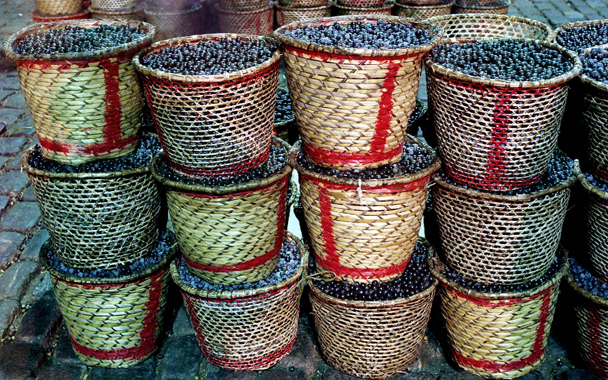You can hardly go on the Web these days without seeing advertisements for açaí (ah–sah–EE), the small, purple berry native to the Amazon. Plastered all over social-networking sites such as Facebook and MySpace, the ads lure consumers in with “risk-free” trials and promises of weight loss, increased energy, and hefty doses of antioxidants. And they are working: Last year, sales of açaí products in the United States reached some $15 million (up from $500,000 in previous years), according to the Better Business Bureau.
But many of these offers are actually scams, and the Center for Science in the Public Interest has gone so far as to compare them to the schemes of Bernie Madoff. These Web ads use false celebrity endorsements (Oprah and Rachael Ray are particularly common), make unsubstantiated weight-loss claims, and beckon shoppers with trials that aren’t quite as “risk-free” as they purport to be. The BBB has received thousands of complaints from angry consumers who, after signing up for trials of açaí supplements, either couldn’t shake recurring charges from their credit card statements or never received the products at all. And even if they did, says the BBB, “health experts question the legitimacy of the weight loss claims.”
If the online businesses aren’t what they seem, what does that say about açaí itself—specifically, the juices and supplements derived from it, which are now being touted in vitamin stores across the country for their antioxidant properties? According to Dr. Eric Decker, head of the Food Science department at the University of Massachusetts Amherst, açaí does likely have some antioxidant benefits. But an experiment last year at UCLA revealed that the berry is actually lower in antioxidant potency than many other sources, including red wine and pomegranate, grape, and blueberry juices. How can marketers make these claims? “There are many ways to measure antioxidant activity in test tubes,” Decker says. “Unfortunately, these tests have never been shown to have a link to improving human health. In fact, many of the compounds that show antioxidant activity in test tubes aren’t even absorbed into our blood.”
Meanwhile, back in its native Brazil, açaí plays an entirely different, scandal-free role. In the Amazon, where the açaí palm tree grows, the fruit has long served as a key source of calories for the local population. Traditionally, the people of the Amazon estuary generally eat two servings of fresh açaí a day, often mixed with manioc flour and as an accompaniment to meat or fish. Far from being a “fashion food,” it provides a significant percentage of daily caloric intake—possibly as much as 30 percent.
Over time, as fruits from the Amazon have gained popularity in other regions of Brazil, particularly urban centers such as Rio de Janeiro, açaí achieved a certain status, synonymous with a young, active lifestyle. These days, it’s available at juice bars and cafés all over Rio, where its pulp is blended with sweeteners like sugar, honey, or guarana syrup (unsweetened, açaí tastes like clean dirt) into a thick, dark-purple concoction. You order it in a cup (copo) or bowl (tigela), plain or enhanced with granola, peanuts, protein powder, or other fruits. Cariocas (residents of Rio) view açaí as everything from a good source of energy for athletes to a pick-me-up for someone who is ill. But they certainly don’t see it as a means of losing weight—quite the opposite. Ask any carioca, and they’ll tell it to you straight: “Açaí makes you fat.”
In the U.S., the açaí trend may be having an adverse impact on both our pocketbooks and our waistlines, but we’re far from the only ones affected. According to Professor Eduardo Brondizio of Indiana University, who recently authored a book on açaí and Amazon forest farmers, “very little of the global economy of açaí returns to the region.” Even though some farmers benefit, he says, “you don’t see much improvement in the region as a whole in terms of education, infrastructure, or health services.” Even worse, Dr. Brondizio adds, “growing demand is putting pressure on the cost and availability of açaí consumed locally, particularly by low-income urban populations,” which would be particularly devastating for the local communities that depend on the fruit for sustenance.
How ironic if, in our search to shed ourselves of excess calories, we ended up robbing the Amazon inhabitants of theirs.
Want to try açaí the way cariocas make it? Here are some Brazilian spots in the U.S. that serve it the way they do in Rio de Janeiro:
Rio’s Mania 37-05 28th Ave., Astoria, NY (718-777-1017)
Muqueca Restaurant 1093 Cambridge St., Cambridge, MA (617-354-3296; muquecarestaurant.com)
Padaria 2000 1051 E Sample Rd., Pompano Beach, FL (954-781-1594)
Pão Gostoso (multiple locations) 5472 International Drive, Orlando, FL (203-885-1025); 10-12 Main St., Danbury, CT (203 796-0670; paogostoso.com)

